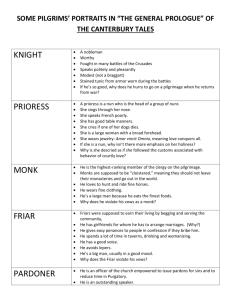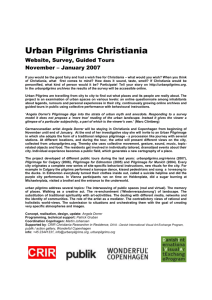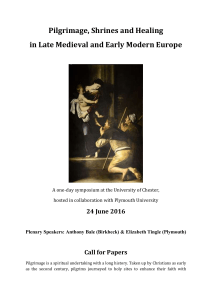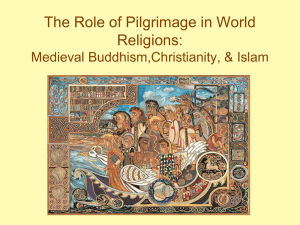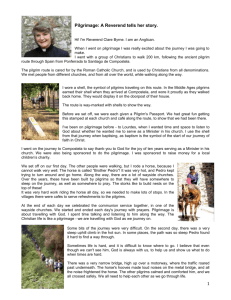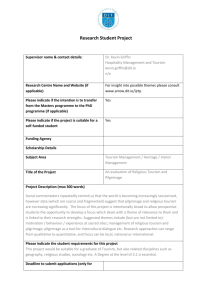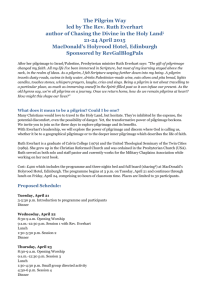The Journey of the Medieval Female Pilgrim World History Name: E
advertisement
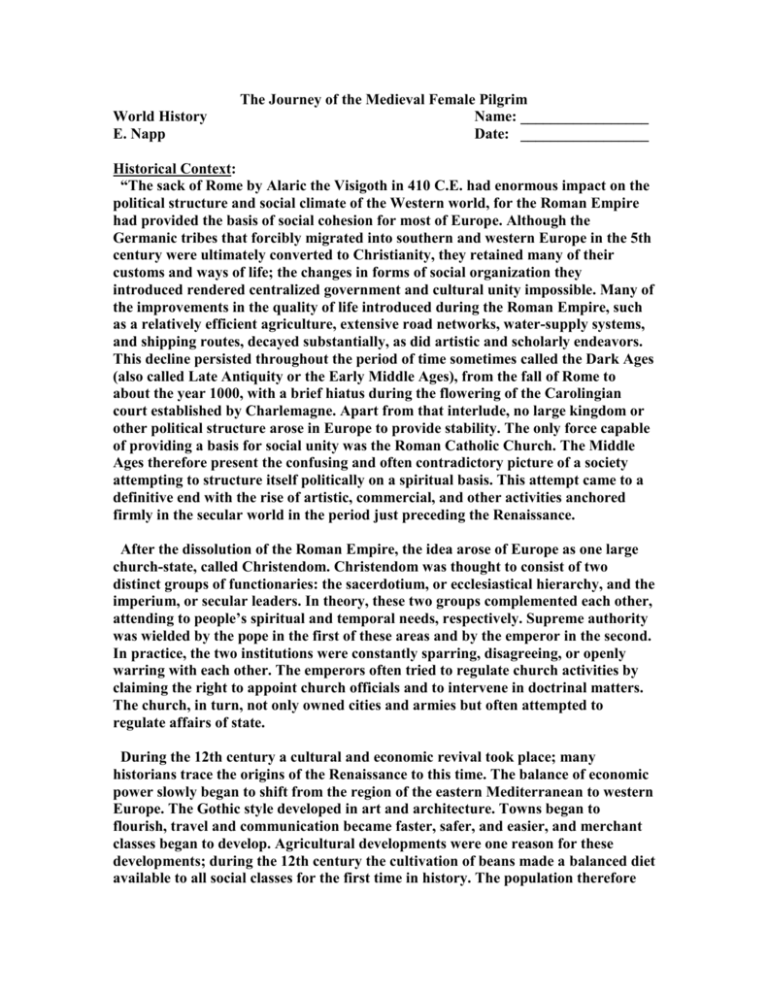
World History E. Napp The Journey of the Medieval Female Pilgrim Name: _________________ Date: _________________ Historical Context: “The sack of Rome by Alaric the Visigoth in 410 C.E. had enormous impact on the political structure and social climate of the Western world, for the Roman Empire had provided the basis of social cohesion for most of Europe. Although the Germanic tribes that forcibly migrated into southern and western Europe in the 5th century were ultimately converted to Christianity, they retained many of their customs and ways of life; the changes in forms of social organization they introduced rendered centralized government and cultural unity impossible. Many of the improvements in the quality of life introduced during the Roman Empire, such as a relatively efficient agriculture, extensive road networks, water-supply systems, and shipping routes, decayed substantially, as did artistic and scholarly endeavors. This decline persisted throughout the period of time sometimes called the Dark Ages (also called Late Antiquity or the Early Middle Ages), from the fall of Rome to about the year 1000, with a brief hiatus during the flowering of the Carolingian court established by Charlemagne. Apart from that interlude, no large kingdom or other political structure arose in Europe to provide stability. The only force capable of providing a basis for social unity was the Roman Catholic Church. The Middle Ages therefore present the confusing and often contradictory picture of a society attempting to structure itself politically on a spiritual basis. This attempt came to a definitive end with the rise of artistic, commercial, and other activities anchored firmly in the secular world in the period just preceding the Renaissance. After the dissolution of the Roman Empire, the idea arose of Europe as one large church-state, called Christendom. Christendom was thought to consist of two distinct groups of functionaries: the sacerdotium, or ecclesiastical hierarchy, and the imperium, or secular leaders. In theory, these two groups complemented each other, attending to people’s spiritual and temporal needs, respectively. Supreme authority was wielded by the pope in the first of these areas and by the emperor in the second. In practice, the two institutions were constantly sparring, disagreeing, or openly warring with each other. The emperors often tried to regulate church activities by claiming the right to appoint church officials and to intervene in doctrinal matters. The church, in turn, not only owned cities and armies but often attempted to regulate affairs of state. During the 12th century a cultural and economic revival took place; many historians trace the origins of the Renaissance to this time. The balance of economic power slowly began to shift from the region of the eastern Mediterranean to western Europe. The Gothic style developed in art and architecture. Towns began to flourish, travel and communication became faster, safer, and easier, and merchant classes began to develop. Agricultural developments were one reason for these developments; during the 12th century the cultivation of beans made a balanced diet available to all social classes for the first time in history. The population therefore rapidly expanded, a factor that eventually led to the breakup of the old feudal structures. The 13th century was the apex of medieval civilization. The classic formulations of Gothic architecture and sculpture were achieved. Many different kinds of social units proliferated, including guilds, associations, civic councils, and monastic chapters, each eager to obtain some measure of autonomy. The crucial legal concept of representation developed, resulting in the political assembly whose members had plena potestas – full power – to make decisions binding upon the communities that had selected them. Intellectual life, dominated by the Roman Catholic Church, culminated in the philosophical method of Scholasticism, whose preeminent exponent, St. Thomas Aquinas, achieved in his writings on Aristotle and the Church Fathers one of the greatest syntheses in Western intellectual history. The breakup of feudal structures, the strengthening of city-states in Italy, and the emergence of national monarchies in Spain, France, and England, as well as such cultural developments as the rise of secular education, culminated in the birth of a self-consciously new age with a new spirit, one that looked all the way back to Classical learning for its inspiration and that came to be known as the Renaissance.” ~ Britannica The Article: Women Pilgrims of the Middle Ages; History Today Magazine, Diana Webb, Volume: 48 Issue: 7, 1998 ‘Do you not realize you are a woman and cannot go just anywhere?’ With these words, the holy man Abba Arsenius, somewhere around the beginning of the fifth century, rebuked ‘a very rich and God-fearing virgin of senatorial rank’ from Rome who had sought him out in his Egyptian solitude. His anxiety was on his own account, not on hers: ‘it is through women that the enemy wars against the Saints’. He conjured up a nightmare vision that she would encourage her Roman sisters to ‘turn the sea into a thoroughfare with women coming to see me’. Pious women were in this period indeed eagerly engaged in pilgrimages, which often combined visiting the Holy Places with seeking out prominent holy men. Arsenius was not alone in feeling that God-fearing virgins should be discouraged from this inappropriate mobility and encouraged to gratify their ascetic impulses in seclusion. It was a sentiment with a big future. However popular pilgrimage became in the medieval centuries, and however meritorious it was generally believed to be, it was never officially regarded as indispensable to salvation. This of course made it easier to forbid it to certain Christians, and from its earliest days it was the object of criticism. This tended to focus on two issues which frequently became inextricably intertwined. On the one hand, the idea that the holy could be found concentrated in particular places was thought to contradict the essentially spiritual nature of Christianity; on the other, gadding about to shrines could easily degenerate into mere tourism or worse, a spiritually aimless wandering affording opportunity for all sorts of immorality away from the eyes of neighbors and superiors. In principle these criticisms applied to pilgrimage undertaken by men and women alike. What came to be the standard version of the religious life in the West, Benedictine monasticism, enjoined stability on both monks and nuns. St Benedict’s well-known denunciation of wandering monks amounted to a rejection of a conception of pilgrimage which had taken root especially among Celtic Christians: the perpetual uprooting of the self from familiar surroundings into penitential wandering, possibly lifelong and not always directed to particular shrines. To judge from the words of an Irish female recluse to St Columbanus, some time around 560, women who sought perfection within this tradition were aware of some limitations: I, too, as far as I have been able have gone out to war. It is fifteen years since I left my home and sought out this place of pilgrimage... and if my fragile sex had not stood in the way, I would have crossed the sea and sought out a place of more fitting pilgrimage. Did the words ‘fragile sex’ denote moral or physical weakness, or both? It certainly became the orthodox view that stability and seclusion were particularly vital to female religious, and it followed that they should be debarred from pilgrimage as from other excuses to leave the cloister. Not all women were nuns, however. Did the belief that women could not ‘go about as they pleased’ influence later attitudes to the practice of pilgrimage by laywomen? It might justly be contended that neither men nor women were often totally free to go as they pleased in the Middle Ages. Few were exempt from the supervisory power of social or ecclesiastical superiors. Monks, like nuns, were bound to seek permission to leave the cloister. The male serf was no less securely tied to the soil than his womenfolk; Richard II’s government tried to prevent both male and female serfs from leaving their appointed places ‘by color of pilgrimage’. Noble men and ladies were well-advised to seek license and safe-conduct from their rulers if they wished to travel abroad. It is against this background that any greater degree of reserve about female freedom of movement has to be assessed, and we need also to ask exactly from what roots it grew. Did wandering women pose a moral and spiritual threat principally to men or to themselves? Was there, perhaps, concern that because they were more vulnerable to physical danger while travelling, they inevitably imposed a burden of responsibility and protection on men? It may of course be difficult to disentangle these lines of thought; and one man’s views might be ambivalent. What are the main points of the passage? 123456- 78910In 747, St Boniface wrote to Cuthbert, Archbishop of Canterbury, advising him to take steps to prevent ‘matrons and veiled women’ from making frequent pilgrimages to Rome. ‘There are very few towns in Lombardy or Frankland or Gaul’ he wrote, ‘where there is not a courtesan or a harlot of English stock. It is a scandal and a disgrace to your whole church.’ It has been suggested that this letter shows Boniface changing his mind about the desirability of female pilgrimage. Some years earlier he had written to the Abbess Eadburga, refusing to take it upon himself to advise her for or against a pilgrimage to Rome, but quoting with approval the words of ‘our sister Wiethburga’, who had found peace of mind at the shrine of St Peter. We know from a letter of King Aethelberht II of Kent that Eadburga in fact made her pilgrimage and met Boniface himself at Rome, perhaps in 745 when he attended a council there. Does the letter to Archbishop Cuthbert, only a few years later, indicate sudden misgivings Boniface had not felt earlier? Or was he neither the first nor the last man in recorded history to express generalized doubts about women which he did not feel about individuals who were well known to him? Boniface identifies two classes of women, matronae (married women or, more likely, widows) and nuns, who were by the middle of the eighth century flocking from England to Rome. We can follow the imaginary trails left by these two classes of female pilgrim down through the centuries to a fictional Canterbury in 1370: one trail ends with Chaucer’s Prioress, who perhaps really should not have been out of her cloister, and the other with the Wife of Bath, a matrona several times over. Her activities may have raised eyebrows, but was her right to go on pilgrimage open to question? In 791, less than half a century after Boniface’s letter to Cuthbert, the Synod of Friuli legislated to safeguard and enforce the enclosure of ‘monasteries of maidens living under a rule’. The relevant canon includes a specific prohibition of pilgrimage, and the terms it employs are suggestive: At no time whatsoever shall it be permitted to an abbess or any nun to go to Rome and tour other holy places, if Satan should transform himself into an angel of light and suggest it to them as if for the sake of prayer. For no one can be so obtuse or stupid as not to realize how irreligious and blameworthy it is [for them] to have dealings with men because of the necessities of travel... That women, lay or religious, could not travel without men in their company was a truth universally acknowledged. For female religious this was (or should have been) an insuperable difficulty; for female pilgrims in general it was a problem, as we shall see more fully later. In theory strict enclosure was required of monks and nuns alike. Four hundred years after the Synod of Friuli, efforts were being made in England to limit the mobility of religious in general. A legatine council held at York in June 1195 by Archbishop Hubert Walter, for example, ruled that monks, regular canons and nuns should not be permitted to leave their houses without just cause and without appropriate escort. Pilgrimage was mentioned among the causes of ‘wandering’ which were to be forbidden. However, the saving clause ‘without specific and reasonable cause’ potentially furnished a very elastic loophole, and the additional note that nuns in particular were not to leave the cloister unless accompanied by the abbess or prioress indicated that enclosure was not in fact expected to be total. Later legislation repeated these prohibitions, tending to focus more narrowly on nuns. Cardinal Ottobuon Fieschi’s legatine council of 1268 in London decreed that the abbess and other superiors were only to leave the convent in case of evident necessity, the other nuns never, but again there was the inevitable saving clause, ‘unless for just and reasonable cause’. Here, no specific mention was made of pilgrimage, and when in 1298 Pope Boniface VIII pronounced on the subject in the ominously entitled Bull Pericoloso he focused on secular and legal business as the causes most likely to drag nuns out of the cloister. The English bishops dutifully disseminated this Bull. Archbishop Thomas Corbridge of York, interpreting it as enjoining ‘perpetual enclosure’, made a spirited attempt to enforce it on the nuns of his diocese, which evidently met with an equally spirited response. In 1344 Bishop Hamo de Hethe of Rochester complained that the nuns of Malling had been infringing on their enclosure in all sorts of ways, including wandering around the country ‘by color of pilgrimage and visiting your friends’, and he exacted an oath of amendment from the abbess and convent. What are the main points of the passage? 12345678910Some restrictions were clearly widely accepted. Philip VI of France failed to persuade Pope Clement VI to grant the benefits of the 1350 Roman Jubilee Indulgence to ‘enclosed nuns’ who, among other classes of people, were not able to make the journey. The name of only one nun, the Abbess of Barking, appears among the permissions granted by the English royal government to go to Rome for the Jubilee. It was not just in 1350 that this was exceptional. No other nun appears among the fairly abundant records of royal permissions to go abroad on pilgrimage which survive in the Patent and Close Rolls in the thirteenth and fourteenth centuries. Abbots occur occasionally, while monks sometimes went with or without the permission of their superiors. Domestic pilgrimage, which leaves less mark on the record, was probably less contentious, and it is a fair inference that it was on modest little pilgrimages within the kingdom that nuns like Chaucer’s Prioress betook themselves from time to time. Occasionally the popes gave permission for a female recluse – a different category of religious woman – to go on pilgrimage. What of the Prioress’s fellow-pilgrim, the Wife of Bath, and other matronae? There was no legislation to stop married women going on pilgrimage, even without their husbands, as long as they had obtained a public statement of their spouse’s permission, a requirement laid down by the Council of Westminster in 1195 which in theory applied to married people of both sexes. Two hundred years later, Margery Kempe of Lynn was well aware of the need for her husband’s consent to her pilgrimages, but she resisted the demand of the hostile ‘doctor’ who arraigned her in the chapter-house at York, while she was visiting the shrine of St William, that she should be able to produce a written permission: Sir, my husband gave me permission with his own mouth. Why do you proceed in that way with me more than you do with other pilgrims who are here, and who have no letter any more than I have?’ Occasionally feminine disobedience to husbands in the matter of pilgrimage appears as a motif in a miracle-collection of saint’s Life. There is an example among the tenth-century miracles of Ste Foy at Conques: a woman in an advanced state of pregnancy had come to the shrine against her husband’s will and was suddenly seized by the pains of impending labour. The saint intervened and on consideration of the gift of a ring from the woman’s finger arrested the course of nature, so that she could return safely to her husband and give birth in due time. This and other miracle-collections provide abundant evidence that women were constant customers of the saints, petitioning or giving thanks on their own account, sometimes on that of their husbands, above all on that of their children. What are the main points of the passage? 12345678910Women expected to have access to popular relics. Early in the ninth century mixed crowds flocked to the abbey of Fleury when new relics were brought there. As women could not enter the monastery church, the relics were exhibited at fixed times in a marquee outside. A similar well-publicized instance occurred in the thirteenth century at the Cistercian abbey of Pontigny. Edmund of Abingdon, late Archbishop of Canterbury, was buried there in 1240 and on his canonization in 1246 flocks of pilgrims had recourse to his tomb, including many Englishwomen of rank. Popes Innocent IV and Alexander IV successively issued special permissions for women to enter the abbey to do reverence to the saint. The chronicler of another Cisterican house, Meaux in Yorkshire, many years later gave a sardonic version of these events. The monks of Pontigny, he said, had favored the women’s devotion and, still more to the point, had been reluctant to forego their offerings. So they had detached the saint’s arm and exhibited it separately at the gates of the monastery, ‘so that the women were not totally disappointed of their devotion, and they themselves obtained no small profit from their offerings’. God and the saint himself, however, were not best pleased by these proceedings, and refused to work any more miracles. Another monastic establishment, the cathedral priory of Durham, prevented women from approaching the shrines of St Cuthbert. This exclusion had a different result. Two-thirds of the miracles recorded in the late twelfth century as performed by Godric (d. 1170), the saint of neighboring Finchale, benefited women, and in at least one instance St Cuthbert himself directed the sufferer to Finchale for her cure. Other saints and shrines catered for a distinctively feminine clientele. In the earlier sixteenth century Sir Thomas More poked gentle fun at housewives who spent more on a pilgrimage to the housekeeper-saint Zita in order to find lost keys than the keys were worth in the first place. Women, it may be suggested, were essential contributors to the shrine economy; and it seems that their right to participate in pilgrimage, as it became more and more integral to lay religious practice, was taken largely for granted. Restrictions on that participation, particularly on long-distance pilgrimage, may well have been imposed as much by practical as by moralistic considerations. A head-count of pilgrims would undoubtedly show men in a large majority, and there were good reasons why this should be so. Such head-counts of course are not easy to achieve, for lack of sufficiently detailed evidence, but one example can be quoted. The Opera, or office of works, of St James in the cathedral of the Tuscan city of Pistoia from about 1360 kept a record of its almsgiving to pilgrims, mostly en route to Compostela. Between 1360 and 1460 some 3,000 pilgrims were recorded, most though not all of them by name. (There must have been many more, because there is a gap in the record from 1407-17.) The interesting fact is that only two hundred or so of the named pilgrims were women and the vast majority of them, for some reason, performed their pilgrimages before 1400 rather than after. Among these few women, however, were some of lowly social rank (a laundress and a cook) and one or two who went both to Compostela and the Holy Land. The popularization of pilgrimage down the social scale, which potentially opened it up to such women, must also, however, have created many situations in which the man went on pilgrimage and the woman stayed behind to mind the shop. Wives with their husbands, mothers with their sons, and perhaps above all widows, in groups or suitably accompanied according to their rank, nonetheless, figure prominently among recorded pilgrims of the central and later Middle Ages. What are the main points of the passage? 12345678910The young Dominican friar, Felix Fabbri of Ulm, gives a vivid picture of the six rich old women who took ship with him at Venice on his first pilgrimage to Jerusalem in 1480. They were ‘through old age scarcely able to support their own weight’. Some of the noblemen in the party objected to their presence, but they proved their worth when sickness broke out on the ship between Cyprus and the Holy Land and they, completely unscathed, nursed the rest of the company. Felix compared them favorably with the one woman, the wife of a Flemish pilgrim, who was on the ship he took on his second pilgrimage in 1483: ‘restless and inquisitive’, she realized all men’s worst fears, he complained, ‘as she ran hither and thither incessantly about the ship... wanting to hear and see everything.’ The spiritual value of pilgrimage, for men or women, might be debatable, though it was widely believed in; its physical hazardousness was beyond dispute. It would have been a rash man who set off to Compostela or the Holy Land, or indeed on any considerable journey, totally unaccompanied. Many all-male parties of pilgrims got together for the sake of safety and company, whether or not they knew one another previously, and women sometimes attached themselves to such groups of men or to family parties. There is an illustrative anecdote in the life of Bona (d. 1207), who lived as a semi-recluse under the supervision of the Augustinian canons of San Martino in Pisa. At an early age she acquired the habit of seeing Christ, his mother, her sisters and St James in visions, and they subsequently accompanied her on her various pilgrimages. She was especially devoted to St James and on her frequent journeys to and from Compostela, she was sometimes escorted by an old man whom she, if no one else, knew to be the saint himself. More normally she travelled in groups of the usual kind, ‘with other pilgrims’. On one of these journeys, a male pilgrim got separated from the rest of his party and was promptly set upon by a robber. We are given this illustration of the dangers of solitude only because Bona took it upon herself to intervene, knowing that being wounded and left for dead was the least of the pilgrim’s worries; he had two unconfessed mortal sins on his conscience which would damn him unless she cured him. (She got him his money back as well, and converted the robber to the religious life: a good day’s work.) On another occasion, Bona went to the superiors who had charge of her and asked for permission to go on pilgrimage to Rome. This was granted, but she was asked with whom she proposed to travel. Merrily she replied, ‘Guido, Guida and Pietro’, meaning by Guido and Guida Christ himself and the Virgin, her ‘guides’. Perhaps aware that there was a lingering reservation in the minds of her superiors, she asked that a servant called Jacopo, ‘who had often accompanied her’, should go with her to a riverside meadow where she expected to meet her three escorts. Jacopo’s evidently burning desire to be allowed to accompany her to Rome himself is let down gently; he is deeply suspicious of the youth and beauty of Guido-Christ, and needs a great deal of reassurance, to the amusement of all the party, that Bona is not going to be the object of this particular guide’s improper attentions. What are the main points of the passage? 12345678910It is hard to imagine the life of a male pilgrim-saint including such elaborate reference to the provision for his safety en route. In the case of women such as Bona, vowed to the religious life, there was, of course, additional reason for anxiety, since their chastity was their indispensable stock in trade. Two centuries later, Margery Kempe of Lynn, who despite the numerous children she had borne in her early sinful life, had to her own satisfaction mastered the difficult art of how to become a virgin, felt a keen anxiety on the same account. Although Christ himself had assured her that he would keep her ‘from all wicked men’s power’, Margery shows recurrent concern about how, and by whom, she was to be escorted on her various pilgrimages. Abandoned at Venice by the party with which she had gone to the Holy Land, she met Richard, the ‘broken-backed man’ who, it had been foretold, would accompany her. He was nervous of the responsibility, not unreasonably thinking that one man, unarmed, was no great defense for a woman against the hazards of the road. At Assisi, he was only too glad to hand her over to the care of Margaret Florentyne, who had come from Rome for the indulgence of the Portiuncula fittingly accompanied by ‘many knights of Rhodes, many gentlewomen and a fine equipage’. Later in life, having escorted her widowed German daughter-in-law back home, Margery undertook the pilgrimage to Wilsnack on the assurance of the company of a man who promised to see her home to England; but he turned out to be in a perpetual state of nerves, and, she thought, made every effort to be rid of her. Finding herself again abandoned, she made her way to Aachen with a group of rather verminous poor people and saw the relics. Meeting here ‘a worthy woman’ from London, who was travelling more conventionally as ‘a widow with a large retinue’, she thought herself assured of company home, but was disappointed. She then joined forces with a solitary poor friar, but that she should travel alone with him seemed improper to an innkeeper’s wife, who got her accepted into a passing party of pilgrims. In the next town she tried once again to attach herself to the widow from London and was harshly rebuffed. Back in company with the poor friar, who by all accounts was having almost as bad a time as she was, she suffered horribly from fears of rape, especially at night: ‘She dared trust no man; whether she had reason or not, she was always afraid.’ It was a stressful experience, especially given Margery’s anxious personality, but by no means an unintelligible one, nor one that would seem altogether unfamiliar to many modern female travelers. The poor friar, who represents millions of nameless innocuous men throughout the ages, had, she acknowledged, ‘been most kindly and decently behaved to her during the time that they travelled together’. It would be interesting to have his journal: did it add to the stress of his journey – like that of the broken-backed Richard years before, or the querulous man on the road to Wilsnack – that he felt responsible for this woman? It was not primarily the extra hazards that female travelers faced that Abba Arsenius had in mind when he suggested that the pious Roman virgin could not go just anywhere. His view of the restrictions that women should observe were in later centuries enforced (insofar as they were successfully enforced) only on some women, those who entered the institutionalized religious life. Laywomen who wanted to go on pilgrimage obviously encountered certain problems which flowed from their gender and its perceived frailties. (The pilgrim who in 1370 gave birth to a male child in the hospital of San Jacopo at Pistoia was an extreme case.) The monkcustodians of popular relics might, with some grumbling, have to take steps to safeguard their purity against invading female pilgrims; but the devotion and the offerings of these women were worth having. It is hard to imagine the shrines of the Middle Ages without their female clientele. What are the main points of the passage? 12345678910-
